Music interview: Jean-Michel Jarre


In a musical career spanning five decades Jean-Michel Jarre has made a habit of breaking new ground. His 1976 album Oxygène showed artists and record labels that they no longer needed to spend fortunes on lavish recording studios when you could make a worldwide hit that sells 12m copies on a batch of analogue synthesisers at home.
But it’s in the concert arena where the Lyon-born son of a film composer and heroine of the French Resistance has left his greatest mark. On Bastille Day in 1979 he performed to a million people in the Place de la Concorde in Paris; two years later he became the first Western artist to play in Communist China. In the 80s, 90s and 2000s his shows became ever larger and more spectacular, with laser and projections, utilising outdoor venues such as the specie centre in Houston, Texas, London’s Docklands, the Arc de Triomphe in Paris and the pyramids of Giza. His concert at Moscow State University in 1997 holds a Guinness World Record for its audience of 3.5m.
Advertisement
Hide AdAdvertisement
Hide AdBy comparison his forthcoming UK arena tour – which includes a date in Leeds – may seem modest, but it’s one the Frenchman, now aged 67, is looking forward to. Having spent the last five years in the studio working on a collaborative project called Electronica – “which actually became two albums because it became much bigger than I thought” – he says “it’s a great excitement to play in the UK with a fairly visual concept”.


“I’m working with different people,” he says, “it’s also linked to the new album where I mixed a lot the analogue and digital technique and I really feel our days can really be symbolised by this extreme mixture in our day to day lives of the analogue world and the digital world. I’m going to explore this from a visual point of view.”
Jarre traces his inspiration as a performer to the street theatre he witnessed as a child outside his grandparents’ home in Lyon. It was there that he was sent for six months of each year after his father Maurice left to find fortune as a film composer in Hollywood. “I’ve always been intrigued by the idea of hijacking one place for one night,” he says. “The circus coming on the road, just doing their show for one night and leaving the following morning I thought was probably the most poetic and the ultimate way of performance – when you have no second chance on the next Saturday because people have left, and that has influenced me a lot.”
He thought traditional performance spaces ill-suited to the more expansive kind of music that he was intent on creating. “I said at an early stage that electronic music was different from rock ’n’ roll or jazz or classical music and needed probably a different environment. It’s the reason why I started being interested in doing concerts in outdoor situations in the days when you didn’t have arenas in the same way as today – I mean fairly big arenas where you can really express yourself on the stage from a visual point of view with a lot of possibilities.
Advertisement
Hide AdAdvertisement
Hide Ad“When I started you had theatres where you could have rock bands or classical orchestras on one side and on the other side you had these big exhibition halls where you had political parties or boxing games or car companies doing their shows then you were going and playing music in those kind of environments which was not particularly sexy.


“For all those reasons I started to think about making the stage work in a different way which I didn’t realise at the time was quite premonitory of later raves and now what’s happening with festivals where the visual is now one of the main elements of any kind of performance in the world, whatever style of music you are playing.”
The Bastille Day concert in 1979 is seared into his memory. “It took me probably one year to recover,” he says. “It was really, believe or not, a kind of underground project where I was experimenting for the first time by mapping buildings, in the days before mapping, and having giant projections on buildings.
“And then I remember on the Champs Elysées I saw some kind of dark shadow, I thought it was the kind of shadow that comes from the sunset, but actually it was the crowd. I didn’t really realise what was going on. One million people came along. It was like a dream, really.”
Advertisement
Hide AdAdvertisement
Hide AdThe scale of Jarre’s popularity – with total career sales of more than 80m records – is perhaps more intriguing for an artist raised on the avant garde ideas of Pierre Shaeffer, father of musique concrète, and Karlheinz Stockhausen.


“I think Pierre Schaeffer has been my master, my mentor and for me he’s probably one of the most influential musicians and figures in the music of the 20th century,” he says. “He’d really been the first one to think in terms of sound and noise and what he called musique concrète.
“It was very interesting to see that electronic music has nothing to do with American pop, jazz or blues; it’s coming from our European tradition of classical music, long instrumental pieces of music, and not with a kind of pop format. The reason why was Schaeffer and Stockhausen and the BBC [Radiophonic] studios also.
“Electronic music came from Europe. It’s the reason why the French, the German and obviously the British scene are very important – probably more than the American scene, with all respect to the great musicians they have. It’s something linked to our culture, with our different way of thinking, our relationship with sound and with structures. It’s also coming from Futurism in paintings, from cinema in the early days of the 20th century. People like Schaeffer and Stockhausen had been big figures in all this.”
Advertisement
Hide AdAdvertisement
Hide AdThough he had performed in rock bands in his youth, by the late 1960s Jarre was already experimenting with sound – inspired by his grandfather, a musician, engineer and inventor. “He invented one of the first mixing consoles before the war then he was also the creator of one of the first portable turntables with batteries where you could picnic listening to the first singles – it was the ancestor of the iPod.”


Jarre was interested in “twisting and manipulating” sounds. “When later on I went to the Diogenes Rivas Music Centre [in Paris] I rediscovered this fundamental idea for me which actually changed the music we are doing now, that music is not only based on notes and based on intervals but it’s also based on sounds and you can make music by recording the sound of the wind and the rain or a noise in the street and make music with it. That changed the way we are doing music these days. DJs have today become sound designers; it’s almost a classical or traditional way of doing music.”
Forty years on from its initial release on a small French label, Oxygène stands as a pioneering work of electronic music. Its success still staggers its creator. “It’s obviously a big surprise for anybody when it happens, but even more in my case,” he says. “Oxygène had been refused by almost everybody, they said ‘You have no singers, no drummers, you have pieces that are 10 minutes or 12 minutes, you can’t play this on the radio – and on top of it he’s French’.
“Also it was so different in terms of textures and sounds and being made in a home studio. I probably had one of the first home studios at a time when the real, serious music had to be done in big studios; now it’s the reverse and home studios are probably the most common way of producing music, but not in those days.
Advertisement
Hide AdAdvertisement
Hide Ad“Everything was in a sense upside down or not in the classic or traditional system of recording and producing music so it was a huge surprise. What I thought was also interesting was that lots of people – I’m talking from an audience point of view – didn’t even know what kind of instruments I was using for doing this kind of music. That came later on.”
Today he is still crafting hit records. His companion albums Electronica I and II reached the top 10 in the UK. The project involved him travelling all over the world to work with fellow practitioners of electronic music. “The idea behind Electronica was actually to work with people who had been or are a source of inspiration to me, linked in one way or another to modern technology and electronic music over different generations,” he explains. “In days where it’s almost banal to do featuring albums where you send files to people you never meet, who you never even talk to, for this project I really wanted to share DNAs, to share physically the creative process which by the end of the day is a timeless, natural way of doing music or any kind of collective creative work with someone.
“I travelled a lot, to meet people physically in their own environments. Electronic music is actually linked to cities like Berlin, like Paris, like London, Bristol, New York, Brooklyn, Detroit, California, LA. It was something totally special to work in their environment.
“Also electronic music is not like rock ’n’ roll or jazz where you have bands, you don’t have many bands in electronic music; when you have more than one guy you have duets such as Daft Punk or Air but not more.
Advertisement
Hide AdAdvertisement
Hide Ad“Actually it’s quite a solitary activity, like working as a painter does, and I’m really so grateful to be able to have people opening the doors of their studio and sharing very vulnerable moments of the creative process, sharing their recipes, their secrets, their weakness and that makes this project very interesting because of that, because of the fact that so many people, from Massive Attack to Gary Numan, from Hans Zimmer to John Carpenter or F*** Buttons, Pet Shop Boys, Julia Holter, Pete Townshend, Tangerine Dream, Cyndi Lauper, Laurie Anderson, Moby and Air and Sebastien Tellier, all these people are part of my family and through this project it’s also showing that electronic music has a family, it has a future.”
Jean-Michel Jarre plays at First Direct Arena, Leeds on October 13. firstdirectarena.com/